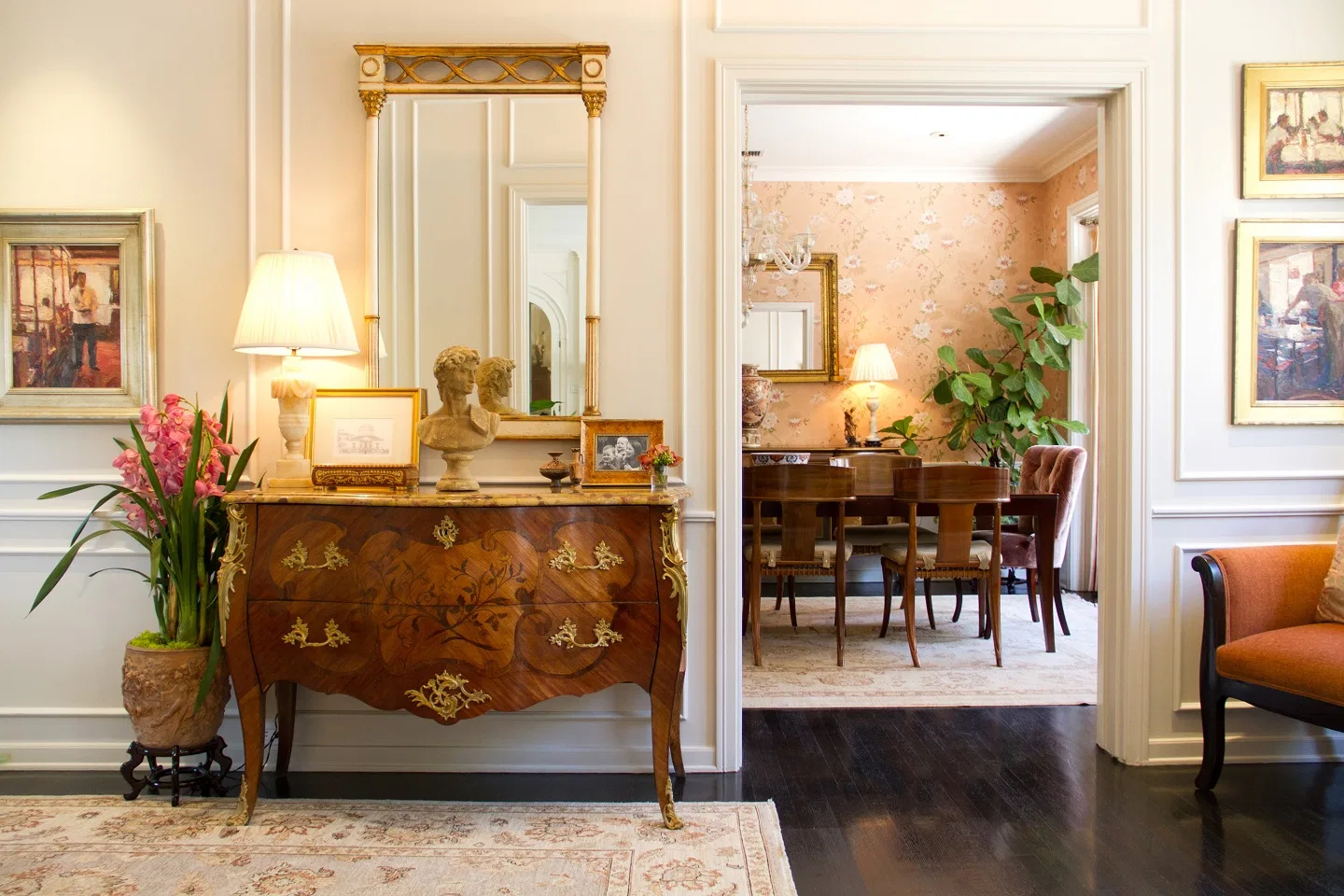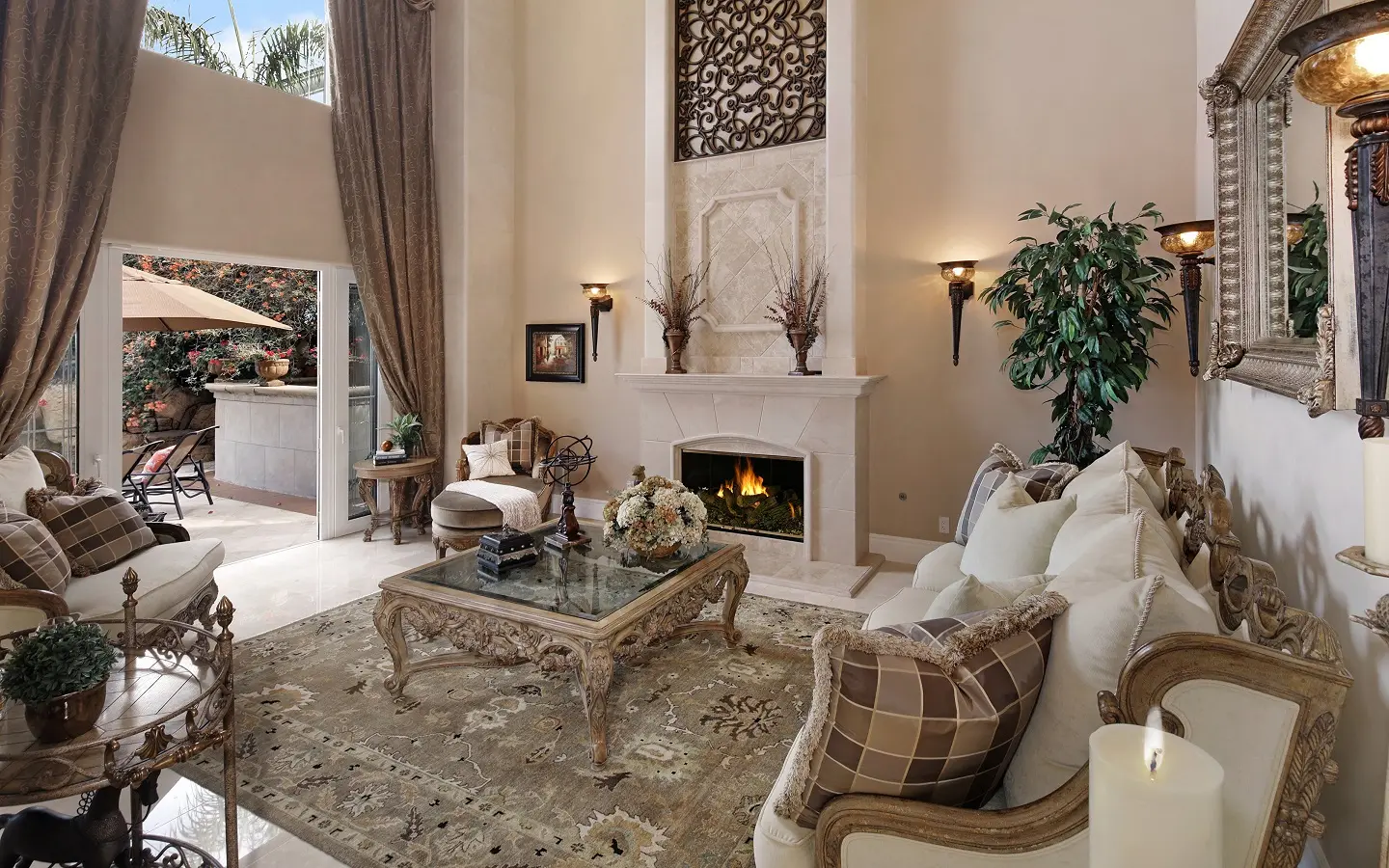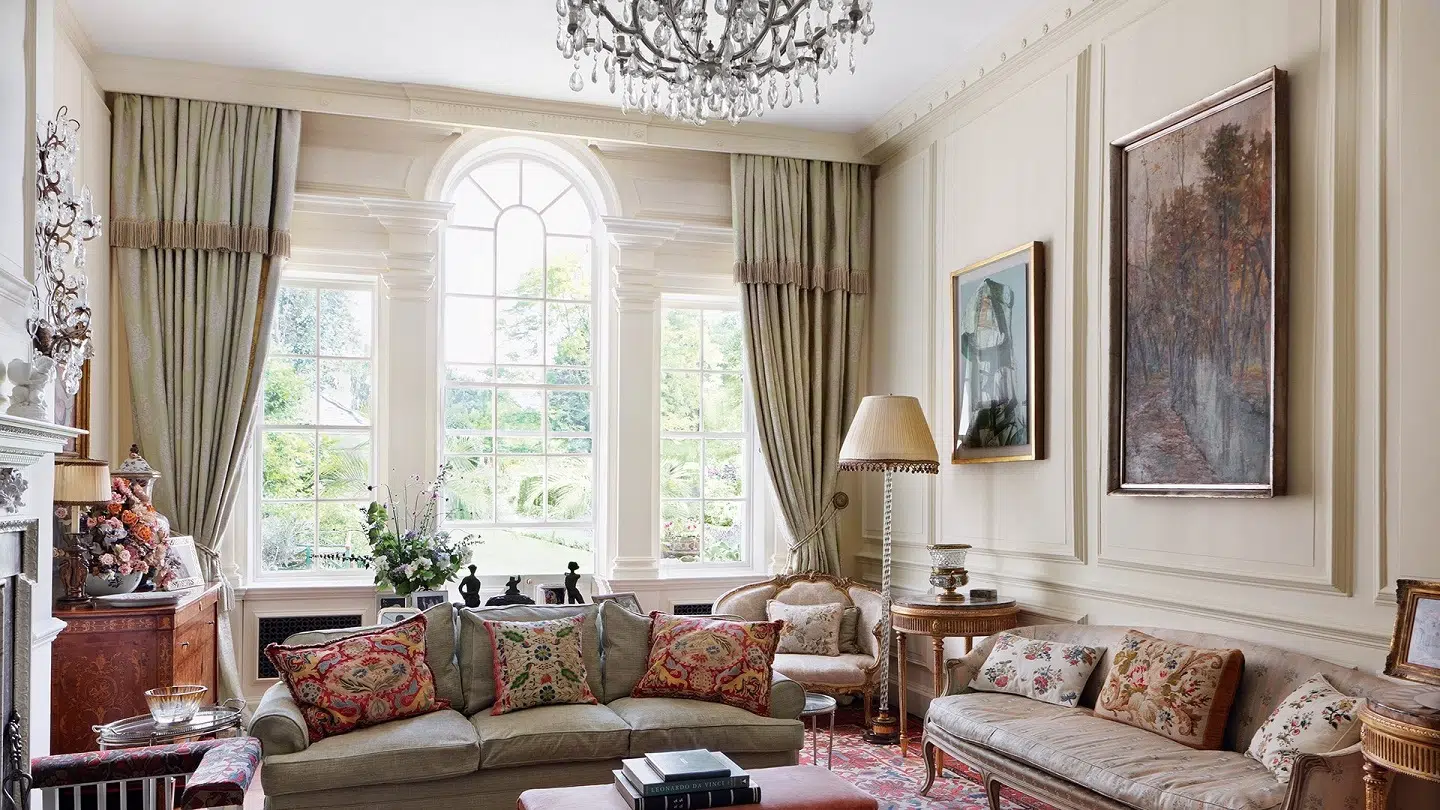Antique Interior Design: Exploring Timeless Elegance

Antique interior design is one of the interior design styles that transports us back in time, evoking the charm and elegance of bygone eras. Rooted in history, this design approach draws inspiration from various historical periods, infusing spaces with nostalgia and sophistication. Whether captivated by the luxury of the Victorian era or the sleek lines of Art Deco, antique interior design offers a treasure trove of possibilities to create a unique and timeless living environment. In this article, we’ll delve into antique interior design, its key elements, tips for achieving the look, and ways to infuse your personality into the mix.
Key Elements of Antique Interior Design

The significant elements of antique interior design, including rugs, solid hardwood flooring, walls, furniture, accessories, and colors, are described here.
Wall Treatments in Antique Interior Design: Wallpaper with classic patterns or historical motifs can transform your space. Alternatively, consider decorative wall paneling or wainscoting for a more traditional look.
Classic Rugs and Carpets: Traditional oriental rugs with intricate patterns can anchor a room and add warmth to hardwood floors.
The Significance of Flooring: Flooring plays a crucial role in antique interior design, as it contributes to the overall ambiance and authenticity of the space. Choosing flooring materials and patterns can greatly enhance the antique look you’re trying to achieve. Here are some flooring options and considerations for antique interior design:
- Hardwood Floors: A classic choice for antique interiors is hardwood flooring. They provide warmth and elegance and can be found in many historic homes. Consider using rich, dark woods like oak, walnut, or mahogany for a more traditional look. Wide plank flooring is also a popular choice as it reflects the style of older home decoration.
- Parquet Flooring: Parquet flooring features geometric patterns created with wood blocks or tiles. It was especially popular during the Renaissance and Baroque periods and can add a touch of sophistication to your space. Different patterns, such as herringbone or basket weave, can suit your preferred era.
- Stone Flooring: Natural stone, such as marble, limestone, or slate, can be used for a timeless and luxurious appearance. Stone flooring is particularly associated with classical architecture and can work well in spaces with antique or neoclassical design elements.
- Tile Flooring: Vintage or antique tiles, such as encaustic cement or Victorian-era patterned tiles, can create beautiful and historically accurate floors. These tiles come in various patterns and colors, allowing you to match the era you’re aiming for.
- Rugs and Carpets: Antique-style rugs or carpets with intricate patterns and vintage designs can be placed on hardwood or tile floors to add comfort and visual interest. These rugs can anchor the room and tie together the overall design.
- Refinishing and Restoration: If your hardwood floors are in good condition but don’t match your desired antique aesthetic, consider refinishing or restoring them to bring out the natural beauty of the wood and allow you to choose a stain that complements your design.
- Area Rugs: If you prefer not to replace or refinish your existing flooring, you can incorporate antique-style area rugs that align with the era you’re emulating. These rugs can add an authentic touch to the space without a complete flooring overhaul.
- Painted Floors: In some antique interior designs, particularly in colonial or farmhouse styles, painted wood floors were common. These floors can be painted in patterns or solid colors to match the overall design theme.
- Vinyl or Laminate Flooring: For a more budget-friendly option that mimics the look of hardwood or tile, you can explore vinyl or laminate flooring with antique-inspired patterns. These materials can provide a vintage appearance without the high cost of natural materials.
When choosing flooring for your antique interior design, it’s essential to consider the historical period you want to evoke and how the flooring choice fits into the overall design scheme. The flooring should complement the furniture, décor, and color palette to create a cohesive and authentic antique look. Additionally, you should factor in maintenance and durability, as antique-style flooring should stand the test of time, just like the design itself.
Period-Specific Furniture in Antique Interior Design: Period-Specific Furniture is the backbone of antique interior design, anchoring the aesthetic in a particular historical era. This carefully selected furniture reflects the distinctive styles, materials, and craftsmanship of a specific period, allowing you to recreate the atmosphere of that era within your living space. For example, the opulent intricacy of Victorian furniture, with its dark, ornately carved wood and heavy upholstery, defines the Victorian era’s grandeur. In contrast, mid-century modern pieces’ sleek lines and minimalistic design epitomize the mid-20th century’s focus on simplicity and functionality. The key to successfully integrating period-specific furniture is authenticity. Finding genuine antique pieces or faithful reproductions that capture the era’s essence is essential. These furniture items are functional elements and artistic expressions, contributing significantly to the overall charm and historical accuracy of your antique interior design.
Lavish Fabrics: Luxurious fabrics like velvet, silk, and damask are a hallmark of antique design. Use these materials for upholstery, curtains, and draperies to create an atmosphere of opulence.
Intricate Detailing: Look for furniture and décor with intricate carvings, gilding, inlays, and decorative elements characteristic of the chosen period. These details add depth and character to your space.
Antique Lighting: Vintage lighting fixtures, like chandeliers, sconces, and lanterns, can lend an air of authenticity and elegance to your rooms.
Vintage Artwork and Mirrors: Adorn your walls with paintings, prints, and large wall mirrors that reflect the style of your chosen era. Gilded frames and ornate designs enhance the vintage aesthetic.
Antique Accessories: Small touches matter. Decorate with vintage or antique accessories like porcelain figurines, antique clocks, candelabras, and vintage books to complete the ambiance.
Right Color Palette: Choose popular colors during the era you’re recreating. Victorian design might feature rich, dark colors, while Art Deco favors bold, geometric patterns and metallic accents.
Tips for Achieving Antique Interior Design

- Mix and Match: Don’t feel constrained to a single historical period. Many antique designs blend elements from different eras to create a unique, eclectic look. This creative approach to antique interior design allows you to blend elements from different historical periods. It’s about juxtaposing diverse styles, materials, and décor to achieve a unique and eclectic aesthetic. For instance, combining Victorian-era furniture with mid-century modern accessories can infuse a sense of surprise and personality into your space. This approach encourages freedom and innovation, enabling you to craft a living environment that honors the past and reflects your taste and style. Mixing and matching in antique design invites you to create a harmonious fusion of the old and the new, resulting in a captivating and dynamic interior.
- Personalization: While antique design is about capturing the past, infusing your personality and preferences into the space is essential. Add personal touches to make it truly your own.
- Care and Maintenance: Antique furniture and décor may require special care to preserve their condition. Regular cleaning and occasional restoration may be necessary to maintain their timeless beauty.
Conclusion

Antique interior design is a captivating journey through history, offering a chance to immerse yourself in the elegance of bygone eras. Whether you’re drawn to the romance of the Victorian period, the simplicity of mid-century modern, or any other era in between, antique design allows you to create a living space that’s both timeless and filled with character. By carefully selecting period-specific elements, infusing your personality, and attending to details, you can transform your home into a haven of vintage charm and sophistication that’s uniquely your own. Embrace the allure of antique interior design and let your space tell a story of the past while celebrating the present.



Did you find what you were looking for?